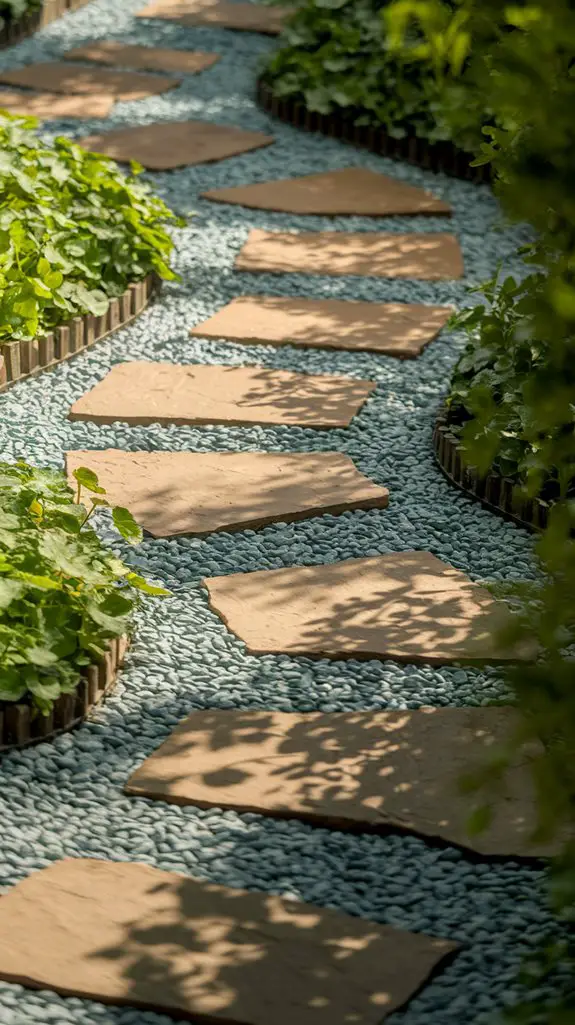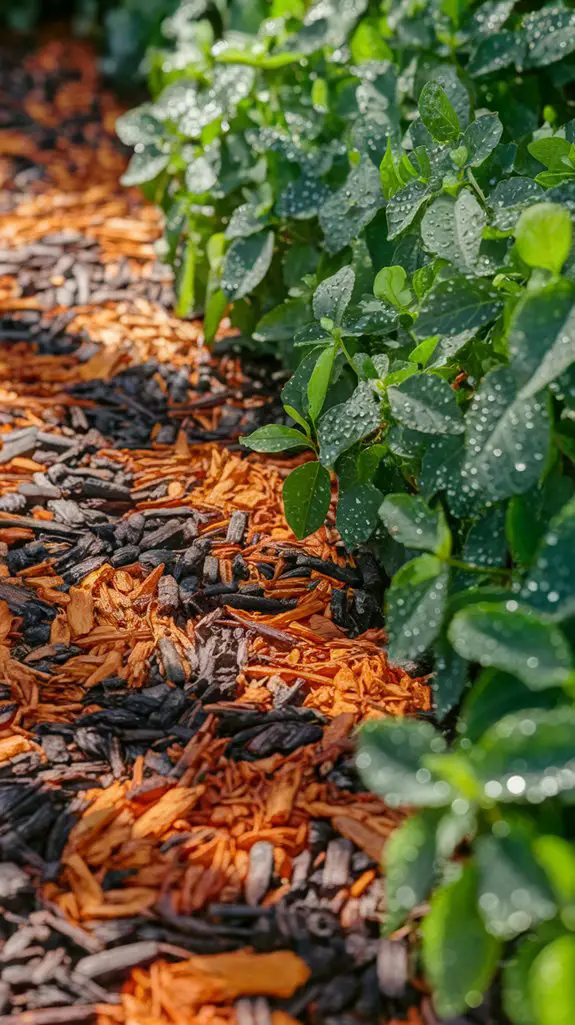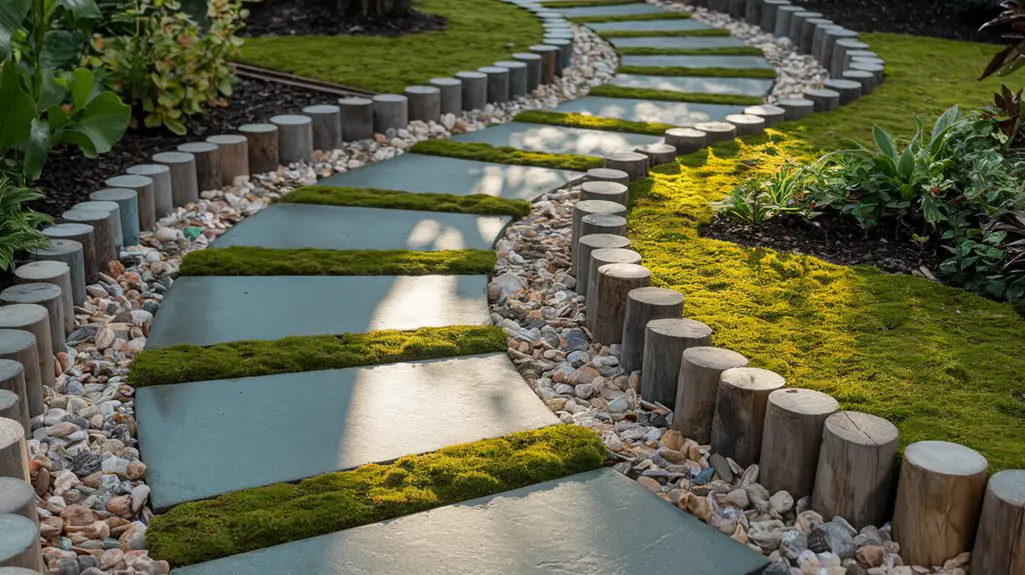Just as every path in life shapes your journey, the materials you choose for your garden walkways impact both your space and our planet. When you create pathways in your outdoor sanctuary, you’re making decisions that extend far beyond aesthetics. Sustainable options like recycled pavers, natural stone, and wood mulch offer beauty while reducing environmental harm. Your choices can transform simple garden connections into powerful statements of environmental stewardship—but which materials truly deserve your consideration?
Recycled Concrete and Brick Pavers
Three exceptional options for sustainable garden pathways are recycled concrete and brick pavers, which transform construction waste into beautiful, functional landscape elements.
You’ll find these materials at salvage yards, demolition sites, or through online marketplace platforms specializing in reclaimed building materials.
Crushed concrete creates permeable pathways that allow rainwater to seep naturally into the soil, reducing runoff and erosion.
Reclaimed bricks offer timeless aesthetic appeal while embodying circular economy principles.
Broken concrete pieces, often called “urbanite,” can be arranged in mosaic patterns for unique, zero-cost walkways.
These materials reduce landfill waste, eliminate energy demands of new production, and create pathways with character and history that improve with age as they weather naturally. Additionally, using recycled materials not only conserves resources but also supports sustainable landscaping practices.
Natural Stone and Gravel Pathways

While recycled materials offer excellent sustainability credentials, locally-sourced natural stone and gravel represent another earth-friendly approach to garden pathway design.
These materials minimize transportation carbon footprints while creating permeable surfaces that allow rainwater to replenish groundwater systems naturally.
You’ll find regional stones like limestone, sandstone, and slate create distinctive pathways that harmonize with your local ecosystem.
Opt for irregular-shaped stepping stones set within fine gravel to maximize drainage and minimize runoff. This design reduces erosion while supporting beneficial microorganisms in your soil.
For gravel pathways, choose angular varieties that lock together, creating a stable surface that requires minimal maintenance.
Consider edges made from fallen timber or native plantings to prevent material migration while enhancing biodiversity around your pathway.
Adding decorative gravel can also enhance aesthetics of garden pathways, providing not only functionality but also visual interest.
The result is a durable, visually appealing connection to nature that treads lightly on the earth.
Wood Chip and Mulch Options

Wood chips and mulch pathways represent perhaps the most accessible eco-friendly option for garden enthusiasts seeking natural circulation routes through their landscapes. They provide a soft walking surface that naturally decomposes, enriching the soil beneath while suppressing weeds and retaining moisture in adjacent planted areas. Utilizing these materials can also help promote effective natural strategies for weed control, ensuring a healthy garden ecosystem.
| Material | Durability | Eco-Benefits |
|---|---|---|
| Pine Chips | 1-2 years | Acidifies soil, local sourcing |
| Cedar Mulch | 2-3 years | Natural pest resistance, aroma |
| Hardwood Mulch | 1-2 years | Carbon sequestration, soil building |
| Cocoa Hulls | 1 year | Repurposed waste product, rich color |
| Leaf Mulch | 6-12 months | Zero waste, nutrient-rich |
You’ll need to replenish these materials periodically as they decompose, but this cycle mimics natural forest floor processes, creating a regenerative pathway system that harmoniously integrates with your garden’s ecosystem.
Permeable Clay Pavers
Permeable clay pavers stand as one of the most historically-rooted yet forward-thinking options for garden pathways, combining ancient building techniques with modern sustainability principles.
These natural clay units allow rainwater to filter between them, reducing runoff and replenishing groundwater tables naturally.
You’ll appreciate how these pavers weather beautifully over time, developing rich patinas that blend seamlessly with your garden’s living elements.
Their earthy tones—ranging from terra cotta to subtle ochres—create visual harmony with surrounding vegetation.
Unlike concrete alternatives, clay pavers don’t leach synthetic compounds into soil.
They’re manufactured from abundant natural materials, requiring less energy to produce than concrete or resin products.
When installed using sand-swept joints rather than mortar, they create a living system that accommodates plant growth and insect habitation in the interstices. Additionally, using sustainable materials like these pavers contributes to a healthier ecosystem by supporting biodiversity.
Crushed Seashell Surfaces
Moving from clay to the ocean’s bounty, crushed seashell paths offer an elegant recycling solution with deep coastal traditions. These calcium-rich surfaces utilize byproducts from seafood industries that would otherwise end up in landfills.
You’ll find shells compact naturally over time, creating a firm yet permeable surface that allows rainwater to filter through to nourish surrounding soil. Their light color reflects heat rather than absorbing it, keeping your garden cooler during summer months.
When sourcing shells, verify they come from sustainable operations rather than harvested beaches. Apply a 2-3 inch layer over landscape fabric to prevent weeds while maintaining drainage.
The gentle crunch underfoot connects you to coastal ecosystems, while the gradual breakdown adds beneficial minerals to your garden soil—a truly circular material choice. Additionally, using eco-friendly materials in your garden pathways can enhance biodiversity and promote healthier ecosystems.
Grass and Clover Walkways
While traditional hardscaping dominates many garden designs, grass and clover walkways offer a living alternative that seamlessly blends into your landscape.
These pathways create soft, permeable surfaces that absorb rainwater, reduce runoff, and support beneficial insects. Additionally, using raised garden beds can further enhance the sustainability of your gardening efforts by improving soil drainage and reducing soil compaction.
For light-traffic areas, consider drought-resistant microclover varieties that stay green with minimal watering and naturally fix nitrogen in soil.
Mix them with tough fescue grasses that withstand moderate foot traffic while requiring less mowing than conventional lawns.
You’ll need to reinforce high-traffic sections with recessed stepping stones or honeycomb stabilizers that provide structure while allowing plants to grow between them.
Unlike concrete or stone, these living pathways actively cool your garden, filter pollutants, and evolve with the seasons—creating a dynamic connection between you and your outdoor space.
Cork and Bamboo Materials
Cork and bamboo represent two rapidly renewable materials that can transform your garden pathways into eco-conscious design statements. Both options offer natural aesthetics while leaving minimal environmental footprints compared to conventional hardscape materials.
| Material | Durability | Maintenance | Installation |
|---|---|---|---|
| Cork | 7-10 years | Low; sweep regularly | Interlocking tiles |
| Bamboo | 15-20 years | Medium; annual sealing | Planks or rounds |
| Cork mulch | 2-3 years | Medium; replenish yearly | Simply spread |
| Bamboo chips | 1-2 years | High; frequent replacement | Layer 2-3 inches |
You’ll find these materials particularly suitable for transitional areas between garden rooms. Their natural resilience to moderate foot traffic makes them perfect for secondary pathways, while their warm tones complement surrounding greenery and create a harmonious, biophilic connection to your outdoor space.
Reclaimed Timber Boardwalks
Repurposed from decommissioned structures, reclaimed timber creates boardwalks that tell environmental stories while providing durable garden pathways. These weathered planks, rescued from old barns, factories, and wharves, bring character through their aged patina and visible history.
You’ll find reclaimed timber particularly effective in wet garden areas where elevated pathways prevent soil compaction. The wood’s natural antimicrobial properties and existing weathering mean it’s already adapted to outdoor conditions. For maximum longevity, look for hardwoods like oak, cedar, or teak.
When installing your reclaimed timber boardwalk, use metal brackets rather than chemical treatments to extend lifespan. Space boards slightly to allow rainwater drainage and prevent rot.
This approach not only diverts waste from landfills but also prevents new tree harvesting, creating a circular material system that honors both past craftsmanship and future sustainability.
Conclusion
Your garden pathway choices can transform your outdoor space into a million tiny ecosystems. By selecting recycled pavers, natural stone, wood chips, or living surfaces like clover, you’re not just creating a path—you’re making a commitment to Earth’s future. These sustainable materials don’t just look beautiful; they work with nature’s systems, allowing water to nourish the soil while reducing your environmental footprint with every step you take.




